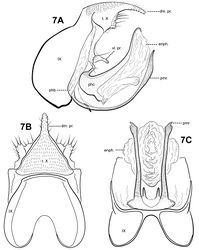Itauara blahniki
| Notice: | This page is derived from the original publication listed below, whose author(s) should always be credited. Further contributors may edit and improve the content of this page and, consequently, need to be credited as well (see page history). Any assessment of factual correctness requires a careful review of the original article as well as of subsequent contributions.
If you are uncertain whether your planned contribution is correct or not, we suggest that you use the associated discussion page instead of editing the page directly. This page should be cited as follows (rationale):
Citation formats to copy and paste
BibTeX: @article{Robertson2011ZooKeys114, RIS/ Endnote: TY - JOUR Wikipedia/ Citizendium: <ref name="Robertson2011ZooKeys114">{{Citation See also the citation download page at the journal. |
Ordo: Trichoptera
Familia: Glossosomatidae
Genus: Itauara
Name
Itauara blahniki Robertson & Holzenthal sp. n. – Wikispecies link – ZooBank link – blahniki Pensoft Profile
Description
Itauara blahniki can be recognized by the shape of the phallicata, which has a pair of very short spines dorsobasally, and a sclerotized lobe ventrobasally. The ventrolateral process of tergum X is also distinct, consisting of a an outwardly projecting flange-like setose process, and an inner, small digitate setose process. Itauara blahniki has elongate, tusk-like parameres. Itauara rodmani sp. n., and Itaura tusci sp. n., also have tusk-like parameres, but unlike Itaura blahniki, these species have flange-like lateral processes on the phallicata. The species also have differently shaped terga X.
Adult. Body, wings, and appendages pale or tawny brown, often intermingled with rufous or golden hairs, tibia and tarsi tawny brown. Wings with conspicuous white spot at the arculus. Forewing slightly broader past anastomosis, but with margins nearly parallel, apex rounded. Forewing venation incomplete, with apical forks I, II, and III present; Sc and R1 distinct along their entire lengths; fork I sessile; fork II sessile; fork III petiolate, stem about the same length as fork; Cu1 complete, reaching wing margin; Cu1 and Cu2 intersecting near anastomosis; row of erect setae present along Cu2; A3 absent; crossveins forming a relatively linear transverse cord; discoidal cell longer than Rs vein. Hind wing margins nearly parallel, tapering only slightly past anastomosis; apical forks II, III, and V present; Sc and R1 fused basally; A2 absent. Tibial spurs 1,4,4, foretibial spur extremely reduced and hairlike. Sixth sternal process thumb-like, apex rounded, associated with oblique apodeme posteriorly.
Male genitalia. Preanal and inferior appendages absent. Segment IX dorsally and ventrally narrow, broad medially; anterior margin rounded; posterolateral margin membranous or very lightly sclerotized; sternum IX without modification. Tergum X incompletely fused to tergum IX with membrane or lightly sclerotized region ventrolaterally; dorsomesal margin with single, downturned, elongate process; dorsolateral margin irregular and setose; ventrolateral margin with paired, outwardly projecting flange-like setose process, and medially with paired digitate setose process. Parameres present, paired, arising ventrobasally from fused endotheca and phallobase, sclerotized and rod-like, slender and elongate, upturned, with distal portion slightly broader, directed dorsally, apex pointed, ventrobasally with small patch of setae. Phallobase reduced, mostly membranous, ventromesally bearing pair of small sclerotized spines. Phallicata forming a long sclerotized dorsal sheath, curving upward, dorsobasally with pair of short processes, ventrally, with lightly sclerotized lobe. Endophallus membranous, enlarged and convoluted when invaginated, with lightly sclerotized lobe ventrally.
Material examined
Holotype male: BRAZIL: Sao Paulo: Estação Biológica Boraceia, Rio Guaratuba, 23°40'02"S, 045°53'46"W, 775 m, 17.ix.2002 (Blahnik, Prather, Melo, Froehlich, Silva) (UMSP000087057) (MZUSP).
Paratypes: BRAZIL: Sao Paulo: same data as holotype except 17.iv.1998 (Holzenthal, Melo, Froehlich) — 1 male (UMSP); same data as holotype — 1 female (UMSP).
Etymology
We are delighted to name this species for Dr. Roger Blahnik, in honor of his many contributions to the systematics of Protoptilinae.
Original Description
- Robertson, D; Holzenthal, R; 2011: Revision of the Neotropical caddisfly genus Itauara Müller, 1888 (Trichoptera, Glossosomatidae) ZooKeys, 114: 41-100. doi
Images
|
